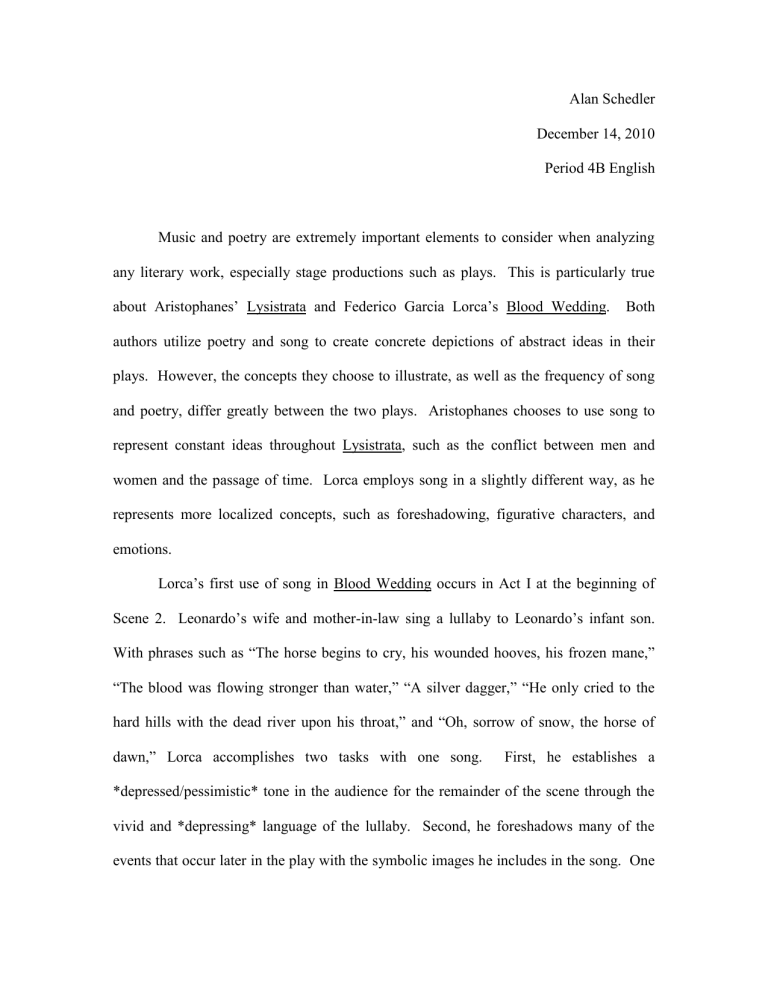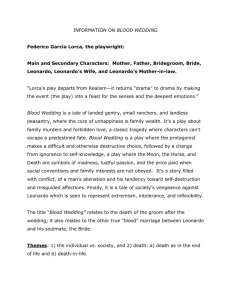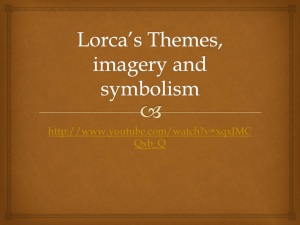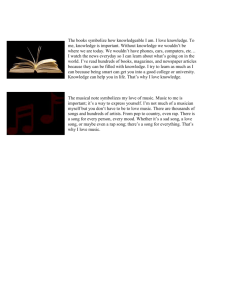AlanEssayComments

Alan Schedler
December 14, 2010
Period 4B English
Music and poetry are extremely important elements to consider when analyzing any literary work, especially stage productions such as plays. This is particularly true about Aristophanes’ Lysistrata and Federico Garcia Lorca’s Blood Wedding. Both authors utilize poetry and song to create concrete depictions of abstract ideas in their plays. However, the concepts they choose to illustrate, as well as the frequency of song and poetry, differ greatly between the two plays. Aristophanes chooses to use song to represent constant ideas throughout Lysistrata, such as the conflict between men and women and the passage of time. Lorca employs song in a slightly different way, as he represents more localized concepts, such as foreshadowing, figurative characters, and emotions.
Lorca’s first use of song in Blood Wedding occurs in Act I at the beginning of
Scene 2. Leonardo’s wife and mother-in-law sing a lullaby to Leonardo’s infant son.
With phrases such as “The horse begins to cry, his wounded hooves, his frozen mane,”
“The blood was flowing stronger than water,” “A silver dagger,” “He only cried to the hard hills with the dead river upon his throat,” and “Oh, sorrow of snow, the horse of dawn,” Lorca accomplishes two tasks with one song. First, he establishes a
*depressed/pessimistic* tone in the audience for the remainder of the scene through the vivid and *depressing* language of the lullaby. Second, he foreshadows many of the events that occur later in the play with the symbolic images he includes in the song. One
example would be the lines in the lullaby that say that “the horse does not want water,” and that “the blood was flowing stronger than water.” In this play, the horse is continually associated with Leonardo. Blood could possibly represent passion or violence, and both eventually prevail later in the play. The opponent to the blood, the water, is also a repeated motif throughout the play. This is a possible representation of purity or fidelity. In addition, Leonardo and the bridegroom kill each other with knives, which is alluded to by the “silver dagger” reference, also in the lullaby.
Aristophanes’ first use of song occurs as the men of Athens are moving to retake the Acropolis from the women who are currently occupying it. The chorus of old men, which is composed of half of 26 members of the traditional Greek chorus, *sings/chants* as they approach the Acropolis. They are met by the chorus of old women, which is composed of the other half of the chorus, who are also *singing/chanting.* This song and poetry of men and women in such close proximity creates a concrete representation of an otherwise abstract element of the story, the conflict between the men and women of
Athens. This division of the chorus provides additional emphasis to this representation, as in traditional Greek stage productions, the chorus was always one unified group rather than two separate halves. *Comparison* Aristophanes also provides additional closure to the conflict at the end of Lysistrata by reuniting the two halves of the chorus upon the conclusion of negotiations.
Lorca’s second use of music occurs in Act II, on the day of the wedding celebration. Everyone in the town is excited and joyful, so much so that they either ignore or fail to notice that the bride is visibly dissatisfied with the event. Lorca employs the town’s celebratory music to contrast with and therefore emphasize the bride’s
depression on her own wedding day. “The bride is awakening on the morning of the wedding! The rivers of the world carry your crown!” is one of the songs that the townspeople sing. The “rivers of the world” are also an additional appearance of the water motif. This repeated appearance expresses the significance that the townspeople placed on fidelity and purity, which seem to be the most likely interpretations of the symbol of water.
Aristophanes’ second use of music is to create a concrete representation of the time that passes as the plot transpires. This is an especially important aspect of
Lysistrata, as the passage of time is essential to the development of the plot. A sex strike by women would not take effect instantly, especially not to the extent exhibited by the male characters in the play. Once again, to accomplish this task Aristophanes employs the use of the chorus, a familiar element of traditional Greek theater.
Federico Garcia Lorca’s final use of song is also the one that occurs most frequently in Blood Wedding. In Act III, Lorca’s playwriting becomes increasingly abstract. In order to communicate which elements of his play are figurative and which should be taken literally, Lorca utilizes *song/poetry* in the dialogue of figurative, representative characters. The first example of this is the moon. The moon, who is accompanied by vivid blue light while on stage, recites a rather lengthy *poem/song* near the beginning of the first scene of Act III. Lorca communicates the moon’s nonliteral nature using *song/poetry* In turn, he uses the moon to narrate the events that occur off stage, particularly the bridegroom’s search for Leonardo and the bride. The moon, much like the lullaby earlier in the play, includes in his lines references to blood and a dagger. This is the fulfillment of the foreshadowing that Lorca created in his Act I
lullaby. Following this lengthy recitation, the moon engages in a conversation with
Lorca’s second representative character, the beggar woman. The beggar woman’s very appearance indicates to the audience what she represents, before she even says a word.
Her shabby, dark green garments communicate to the audience her malicious intent. Her intent is further revealed as she seduces the bridegroom into accepting her help in his search for Leonardo and the bride. She makes several rather dark and disturbing comments in her conversation with the bridegroom, such as “much more beautiful if you were asleep” and “What broad shoulders! Why don’t you want to be laid out on them…”
Both of these comments make rather clear to the audience the beggar woman’s intent to bring the bridegroom to harm. Later, after two sharp screams interrupt the music of the play, the beggar woman appears on stage and stands motionless with her arms outstretched like massive wings. This solidifies the audience’s suspicions that the beggar woman represents death, and that her statuesque pose represents her triumph in killing
Leonardo and the bridegroom.
Both Aristophanes and Lorca use song and poetry to convey abstract ideas to their respective audiences. But furthermore, both authors use song and poetry to enhance their respective topics and themes. One of Aristophanes’ primary topics is gender roles, especially those of women. His use of the divided chorus emphasizes the gender conflict and thereby emphasizes the significance of the topic in the play. One of Lorca’s main themes is that the unwritten rules of a society can often lead to unwanted and unpleasant consequences for the members that do not comply with those rules. Lorca’s use of the celebratory songs to contrast the bride’s dejection especially highlights this theme.
Overall, both playwrites use song and poetry to the utmost effectiveness in order to enhance their literature, which places both in the upper echelon of authors.
Word count: 1200
Name ________________________________________________________ Period ____
_____ (20) Word Choice
___ Lively Verbs
Comments: (An X indicates need for improvement.)
___ Expanded Vocabulary
___ Academic Voice
___ Avoids Cliché
___ Absence of Redundancy
___ Precise Words/Phrases
__affect/effect __accept/except
__real/really __a lot
__its/it’s __can/may
__fewer/less __good/well
__further/farther __lose/loose
__have/of
__if/whether
__use/used
__than/then
__their/they’re/there
__to/too/two
__that/which/who __whose/who
__imply/infer __your/you’re
_____ (20) Organization
___ Indented Paragraphs
___ Hook
___ Intro author/title/brief summary
___ Focus
___ Coherence
___ Balance
_X__ Unity (Strong Closer)
P2-Add CD to support the highlighted claim (how do you know from the song what water represents?)
_____ (20) Sentence Fluency
___ Sentence Combining
___ Sentence Variety/Openers
___ Parallel Structure
___ Transitions
__X_ No run-ons/fragments
___ Agreement -- Tense, S/V
_____ (20) Idea Development
___ Evidence of Prewriting
__ Clear, effective thesis
___ Sufficient supporting details/evidence
___ Demonstrates critical thinking skills
___ Length
Excellent critical thinking and analysis. Well done! The only thing you seem to be lacking is a strong closure.
Your discussion of theme in the final paragraph is powerful. You might add another paragraph to conclude, in which you synthesize all of your previous arguments.
_____ (20) Process and Presentation
___ Evidence of Revision
___ Format
___ Correctness/Conventions
__colons
__commas
__apostrophes
__capitalization
__quotations
__semicolons
_X_citations
__end marks





